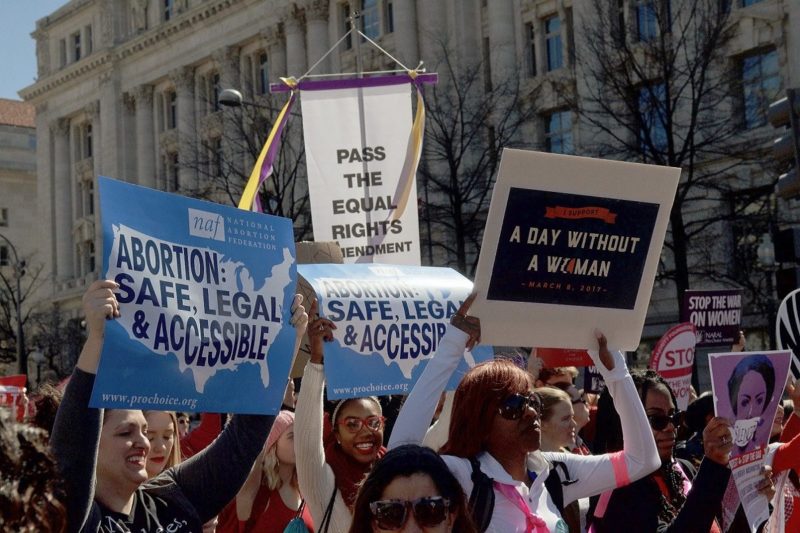Don’t Leave Out Abortion Rights When Rebuilding State Power
Our vision for a healthy, thriving society—with access to and support for the health care we need—requires it.

Over the past several years, the country has seen a steady drumbeat of bad news out of state capitols when it comes to reproductive health and rights. That trend continued in 2017, as conservatives possessed historic control over state legislative chambers nationwide.
The good news: There’s now widespread recognition of the power of states and the need to channel resistance efforts toward reclaiming progressive control from the ground up. State leaders are pushing back against the Trump administration’s agenda on a variety of fronts, and women are at the center of these efforts. As progressives rebuild, and as debates that ought to be settled threaten to resurface, we must make sure that the voices of those most affected by anti-choice efforts are heard—and that reproductive autonomy continues to be a central tenet of the progressive agenda. As the director of the State Innovation Exchange’s (SiX) new Reproductive Rights Program, I’m committed to making this goal a reality.
Conservatives’ drive to roll back reproductive rights is nothing new. States have been laboratories for testing anti-abortion policies for decades. But since 2010, conservatives have accrued a historic number of state legislative majorities, and anti-abortion legislation is at a fever pitch. In 2017 alone, 1,257 provisions related to reproductive health were introduced at the state level. And since 2010, state legislators have enacted more than 350 abortion restrictions across the country. Restrictions have included unnecessary clinic regulations intended to shut down providers, biased counseling requirements, mandatory delays before receiving care, and more.
This avalanche of abortion restrictions at the state level was no mistake. It was a calculated, purposeful strategy driven by national anti-abortion organizations capitalizing on well-funded conservative state legislators. When conservatives won back so many majorities in 2010, they were prepared to act—thanks to a years-long financial investment to the tune of hundreds of millions of dollars from huge donors like the Koch brothers. Republicans’ party platform has explicitly called for a constitutional amendment outlawing abortion, and they now control more than 30 governorships, the majority of state attorney general offices, and two-thirds of all state legislative chambers. The consequences are clear.
The effect of conservatives’ try-everything strategy extends well beyond the impact of the policies themselves. Even when abortion restrictions don’t pass, legislators learn from them. State lawmakers who push these restrictions gain real-time feedback on how to message them from their constituents, the press, and their colleagues. They learn who their legislative allies and opponents are—and how strongly they will or will not fight back. They also learn whether and how the media will cover their efforts, and they can gauge the public’s willingness to accept junk science and outrageous claims. Additionally, the sheer volume of abortion restrictions and the resulting media coverage contribute to a culture of abortion stigma.
And though the results are expensive and outrageous, state legislators who repeatedly introduce restrictive legislation learn how to better advance their anti-women agenda. They become part of a pipeline of elected officials who know how to enact these restrictions. In fact, some of Congress’ leading proponents of criminalizing abortion, like U.S. Reps. Trent Franks (R-AZ) and Matt Gaetz (R-FL), began their careers pushing abortion restrictions in their own statehouses.
Meanwhile, progressive legislators have historically been under-resourced and under-supported, lacking training opportunities and access to the messaging and policy resources they need, even though public opinion—not to mention the medical community—is on our side. Seven in ten women and men continue to agree that Roe v. Wade, the U.S. Supreme Court case legalizing abortion, should not be overturned, and major medical organizations throughout the country continue to recognize that abortion is health care and ought to be treated as such.
So what can we do to address this gap?
The rebuilding of our state progressive infrastructure and the shoring up of our pipeline of progressive elected leaders must include explicit attention to and training around issues of reproductive health, rights, and justice. State lawmakers and leaders must boldly embrace and understand how crucial these issues are to their constituents’ well-being, and they must articulate how connected reproductive health, rights, and justice are to virtually every other part of the progressive platform. SiX’s new Reproductive Rights Program will prepare legislators for this task by helping them identify and articulate their own values around reproductive freedom, as they learn how to move the conversation beyond the four corners of their statehouse and into the hearts and minds of their communities and constituencies.
From the Stupak amendment during the 2010 health care reform fight, to the rights of D.C. residents, to ongoing debates among Beltway insiders, abortion is historically one of the first issues up for negotiation. Let’s learn from these mistakes and work to holistically incorporate issues of reproductive freedom as we invest in rebuilding our progressive movement from the state and local level up. After all, our vision for a healthy, thriving society—with access to and support for the health care we need—requires it.

